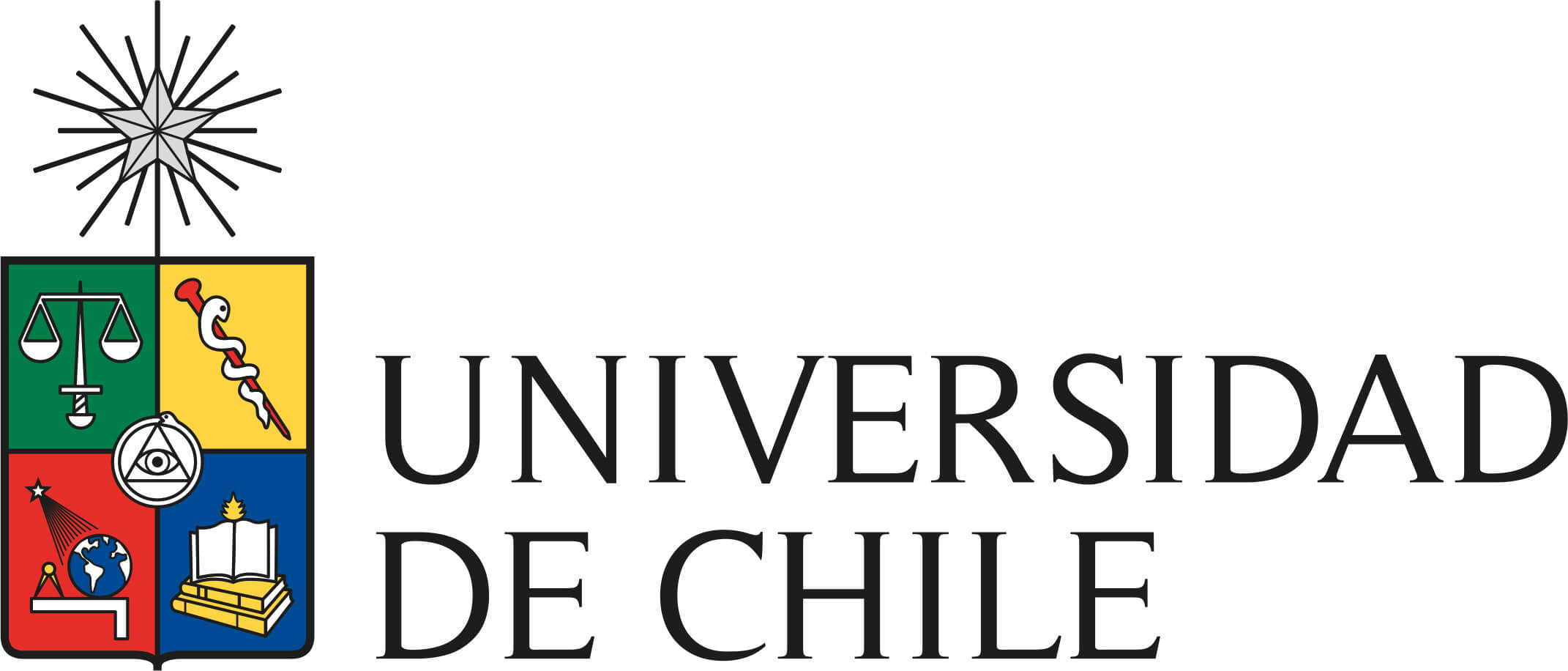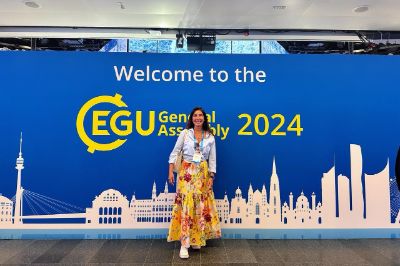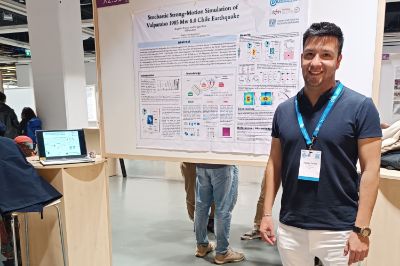Simulación de terremotos, hidratos de gas en sedimentos submarinos, deslizamientos en zonas de subducción, ozono superficial y ríos atmosféricos fueron parte de los temas que abordaron los nueve trabajos de investigación presentados por las y los investigadores del Departamento de Geofísica (DGF) de la Universidad de Chile en la Asamblea General de la Unión Europea de Geociencias (European Geosciences Union General Assembly) EGU 2024.
En la reunión llevada a cabo en Viena, Austria, se presentaron más de 20 mil trabajos de investigación, entre los cuales destacaron como autores/as y coautores/as las y los investigadores del DGF, Rogelio Torres, Lucía Villar, Sergio Ruiz, Eduardo Contreras-Reyes, Diana Comte, Rodrigo Seguel, Lucas Castillo, Charlie Opazo, Laura Gallardo, René Garreaud, Tomás Carrasco, Dipjyoti Mudiar, Roberto Rondanelli, Javier Ojeda y Sebastián Arriola.
“Participar en EGU 2024 representó una valiosa oportunidad para contextualizar el riesgo sísmico presente en América Latina, una región históricamente afectada por grandes terremotos”, dijo el investigador de doctorado del DGF, Rogelio Torres.
El coautor y expositor del trabajo “Stochastic Strong-Motion Simulation of Valparaiso 1985 Mw 8.0 Chile Earthquake” manifestó que “participar en EGU 2024 representó una valiosa oportunidad de compartir conocimientos y experiencias en busca de soluciones a los desafíos de las ciencias de la tierra a nivel global para contextualizar el riesgo sísmico presente en América Latina, una región históricamente afectada por grandes terremotos”.
Por su parte, la investigadora de postdoctorado, Lucía Villar, reconoció que, a pesar de preferir conferencias más pequeñas y centradas en su área de trabajo, valoró haber podido presentar el póster de investigación “The highest gas hydrate volume estimate found in the sediments of the Chilean margin” y reunirse con investigadoras e investigadores de otros lugares del mundo, como el director de como el director de la Oficina Internacional del Instituto de Investigación de Terremotos de la Universidad de Tokio, Masataka Kinoshita.
La Asamblea General de la Unión Europea de Geociencias (European Geosciences Union General Assembly) se realizó entre el 14 y el 19 de abril y contó con la participación de más de 20 mil asistentes.
El detalle de los trabajos presentados por investigadoras e investigadores del DGF en EGU 2024 es el siguiente:
- "Stochastic Strong-Motion Simulation of Valparaiso 1985 Mw 8.0 Chile Earthquake" (Rogelio Torres, Sergio Ruiz).
- "The highest gas hydrate volume estimate found in the sediments of the Chilean margin" (Lucia Villar-Muñoz, Iván Vargas-Cordero, Umberta Tinivella, Michela Giustiniani, Joaquim P. Bento, Nathan Bangs, Eduardo Contreras-Reyes).
- "Subsurface Insights of the Maricunga Gold Belt through LocalEarthquake Tomography" (Diana Comte, Daniela Teresa Calle Gardella, Felipe Bugueño, Valentina Reyes-Wagner, Marcia Ojeda, Andreas Rietbrock, Steven W Roecker).
- "Detection of slow slip events along the southern Peru - northern Chile subduction zone" (Jorge Jara1, Romain Jolivet, Anne Socquet, Diana Comte, Edmundo Norabuena).
- "Joint Tomographic Inversion of the Pampean Flat Slab: Insights from Extensive Archived Seismic Data" (Ariane Maharaj, Steve Roecker, Diana Comte, Mauro Saez, Sol Trad, Gustavo Ortiz, Martín Fernández)
- "Surface Ozone Trends in South America: Unraveling the Influence of Precursor Shifts and Extreme Events" (Rodrigo Seguel, Lucas Castillo, Charlie Opazo, Néstor Rojas, Thiago Nogueira, María Cazorla, Mario Gavidia-Calderón, Laura Gallardo, René Garreaud, Tomás Carrasco, Yasin Elshorbany).
- "Water Vapor Budget Evaluation in Atmospheric Rivers Associated with Heavy Rainfall Events in the Southern Andes" (Dipjyoti Mudiar, Roberto Rondanelli, Raúl A. Valenzuela, René D. Garreaud).
- "Variability in Anelastic Attenuation: Examining Temporal and Spatial Influences on Ground Motion Characteristics in Central Italy" (Simona Gabrielli, Aybige Akinci, Carolina Gutiérrez, Javier Ojeda Vargas, Sebastián Arriola, Sergio Ruiz).
- "Structure and geometry of the Chilean subduction zone near Copiapó (~27°S) based on an amphibious seismic refraction experiment" (Arne Warwel, Dietrich Lange, Anke Dannowski, Sara Aniko Wirp, Eduardo Contreras-Reyes, Ingo Klaucke, Marcos Moreno, Juan Díaz-Naveas, Heidrun Kopp).



